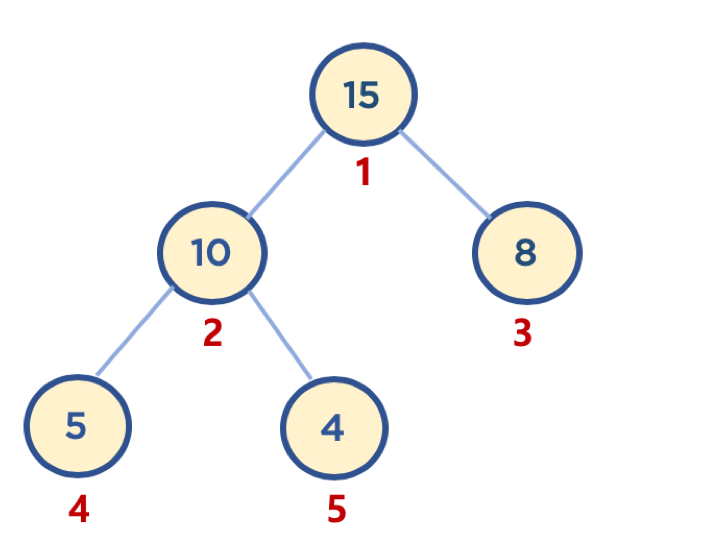자료구조 학습용 예제입니다.
힙과 배열
- 힙(Heap): 데이터에서 최대값과 최소값을 빠르게 찾기 위해 고안된 완전 이진 트리(Complete Binary Tree)
- 완전 이진 트리: 노드를 삽입할 때 최하단 왼쪽 노드부터 차례대로 삽입하는 트리
- 일반적으로 힙 구현시 배열 자료구조를 활용함
- 배열은 인덱스가 0번부터 시작하지만, 힙 구현의 편의를 위해, root 노드 인덱스 번호를 1로 지정하면, 구현이 좀더 수월
- 부모 노드 인덱스 번호 (parent node’s index) = 자식 노드 인덱스 번호 (child node’s index) // 2 (
//: 몫만 구함) - 왼쪽 자식 노드 인덱스 번호 (left child node’s index) = 부모 노드 인덱스 번호 (parent node’s index) * 2
- 오른쪽 자식 노드 인덱스 번호 (right child node’s index) = 부모 노드 인덱스 번호 (parent node’s index) * 2 + 1

This file contains hidden or bidirectional Unicode text that may be interpreted or compiled differently than what appears below. To review, open the file in an editor that reveals hidden Unicode characters.
Learn more about bidirectional Unicode characters
| package blog.heap; | |
| public class Card { | |
| private int number; | |
| private String description; | |
| public Card(int number) { | |
| super(); | |
| this.number = number; | |
| this.description = "CARD"; | |
| } | |
| public Card(int number, String description) { | |
| super(); | |
| this.number = number; | |
| this.description = description; | |
| } | |
| public int getNumber() { | |
| return number; | |
| } | |
| public void setNumber(int number) { | |
| this.number = number; | |
| } | |
| public String getDescription() { | |
| return description; | |
| } | |
| public void setDescription(String description) { | |
| this.description = description; | |
| } | |
| @Override | |
| public String toString() { | |
| return "Card [number=" + number + ", description=" + description + "]"; | |
| } | |
| } |
This file contains hidden or bidirectional Unicode text that may be interpreted or compiled differently than what appears below. To review, open the file in an editor that reveals hidden Unicode characters.
Learn more about bidirectional Unicode characters
| package blog.heap; | |
| import java.util.ArrayList; | |
| import java.util.List; | |
| public class Heap { | |
| private List<Card> heapArr; | |
| public Heap(Card card) { | |
| heapArr = new ArrayList<>(); | |
| heapArr.add(0, null); | |
| heapArr.add(1, card); | |
| } | |
| public List<Card> getList() { | |
| List<Card> outArr = new ArrayList<>(heapArr); | |
| outArr.remove(0); | |
| return outArr; | |
| } | |
| private void swap(int idx1, int idx2) { | |
| Card index1Card = heapArr.get(idx1); | |
| Card index2Card = heapArr.get(idx2); | |
| heapArr.set(idx1, index2Card); | |
| heapArr.set(idx2, index1Card); | |
| } | |
| public Card getCardByNumber(int number) { | |
| for(Card c : heapArr) { | |
| if(c == null) { | |
| continue; | |
| } else if(c.getNumber() == number) { | |
| return c; | |
| } | |
| } | |
| return null; | |
| } | |
| public boolean insert(Card card) { | |
| if(heapArr.size() == 1) { | |
| heapArr.add(card); | |
| return true; | |
| } else if(getCardByNumber(card.getNumber()) != null) { | |
| System.out.println(card.getNumber() + ": == 이미 존재하는 값입니다. =="); | |
| return false; | |
| } | |
| heapArr.add(card); | |
| // rearrange heapArr | |
| int insertedIndex = heapArr.size() – 1; | |
| do { | |
| int parentIndex = insertedIndex / 2; | |
| // System.out.println(insertedIndex + ":" + parentIndex); | |
| // NullException 방지 | |
| if (parentIndex == 0) { | |
| break; | |
| } | |
| if (heapArr.get(parentIndex).getNumber() < heapArr.get(insertedIndex).getNumber()) { | |
| // Swap | |
| swap(parentIndex, insertedIndex); | |
| insertedIndex = parentIndex; | |
| } else { | |
| break; | |
| } | |
| } while(true); | |
| return true; | |
| } | |
| public Card pop() { | |
| //System.out.println("POP시작"); | |
| if (heapArr.size() <= 1) { | |
| return null; | |
| } | |
| Card card = heapArr.get(1); | |
| swap(1, heapArr.size() – 1); | |
| heapArr.remove(heapArr.size() – 1); | |
| // rearrange heapArr | |
| int poppedIndex = 1; | |
| int leftChildIndex, rightChildIndex; | |
| do { | |
| // 자식들은 poppedIndex가 갱신될때마다 재지정해야함 | |
| leftChildIndex = poppedIndex * 2; | |
| rightChildIndex = poppedIndex * 2 + 1; | |
| // case1: 왼쪽 자식 노드도 없을 때 – 자식 노드가 존재할 수 없음 | |
| // System.out.println("leng " + leftChildIndex + ":" + heapArr.size() ); | |
| if (leftChildIndex >= heapArr.size()) { | |
| break; | |
| } else if(rightChildIndex >= heapArr.size()) { | |
| // case2: 오른쪽 자식 노드만 없을 때 – 왼쪽은 있을 때 | |
| if(heapArr.get(poppedIndex).getNumber() < heapArr.get(leftChildIndex).getNumber() ) { | |
| swap(poppedIndex, leftChildIndex); | |
| poppedIndex = leftChildIndex; | |
| } else { | |
| break; | |
| } | |
| } else { | |
| // case3: 왼쪽, 오른쪽 자식 노드 모두 있을 때 | |
| if(heapArr.get(leftChildIndex).getNumber() > heapArr.get(rightChildIndex).getNumber()) { | |
| if(heapArr.get(poppedIndex).getNumber() < heapArr.get(leftChildIndex).getNumber() ) { | |
| swap(poppedIndex, leftChildIndex); | |
| poppedIndex = leftChildIndex; | |
| } else { | |
| break; | |
| } | |
| } else { | |
| if(heapArr.get(poppedIndex).getNumber() < heapArr.get(rightChildIndex).getNumber() ) { | |
| swap(poppedIndex, rightChildIndex); | |
| poppedIndex = rightChildIndex; | |
| } else { | |
| break; | |
| } | |
| } | |
| } | |
| } while(true); | |
| return card; | |
| } | |
| } |
This file contains hidden or bidirectional Unicode text that may be interpreted or compiled differently than what appears below. To review, open the file in an editor that reveals hidden Unicode characters.
Learn more about bidirectional Unicode characters
| package blog.heap; | |
| import java.util.Arrays; | |
| import java.util.Collections; | |
| import java.util.List; | |
| import java.util.stream.Collectors; | |
| public class HeapTest { | |
| public static void main(String[] args) { | |
| Heap heap = new Heap(new Card(15)); | |
| heap.insert(new Card(15)); | |
| int[] nums = new int[100]; | |
| // 1~100 일괄 채워넣기 | |
| for (int i = 0; i < nums.length; i++) { | |
| nums[i] = i + 1; | |
| } | |
| List<Integer> list = Arrays.stream( nums ).boxed().collect( Collectors.toList() ); | |
| Collections.shuffle(list); // 섞기 | |
| List<Integer> selection = list.subList(0, 29); // get 30 numbers | |
| for(int i : selection) { | |
| //System.out.println(i); | |
| heap.insert(new Card(i)); | |
| } | |
| for(int i = 1; i <= 20; i++) { | |
| System.out.println("popped " + i + ": " + heap.pop()); | |
| } | |
| for(Card c : heap.getList()) { | |
| System.out.println(c); | |
| } | |
| System.out.println("List size: " + heap.getList().size()); | |
| } | |
| } |







0개의 댓글